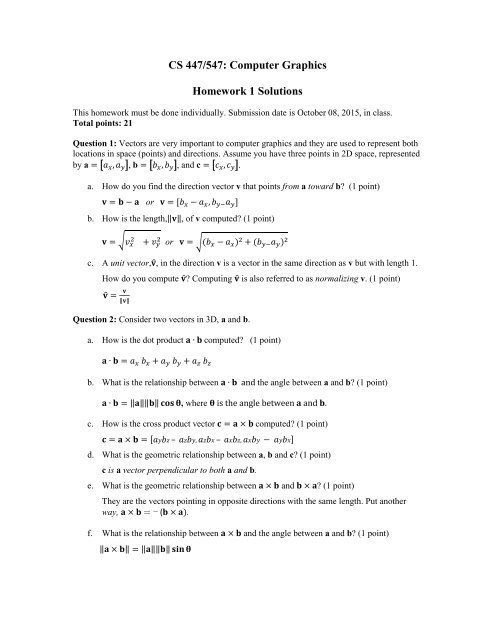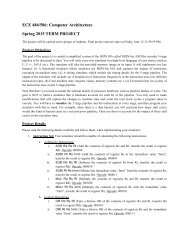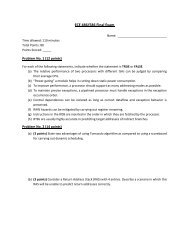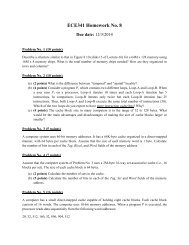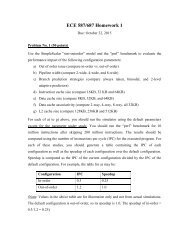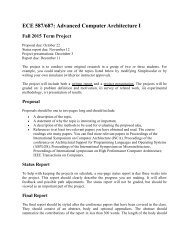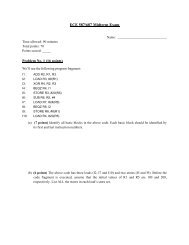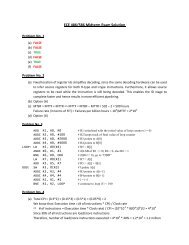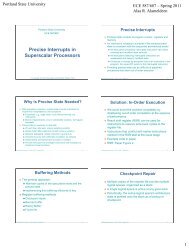CS 447/547 Computer Graphics Homework 1 Solutions
CS 447/547: Computer Graphics Homework 1 Solutions
CS 447/547: Computer Graphics Homework 1 Solutions
Create successful ePaper yourself
Turn your PDF publications into a flip-book with our unique Google optimized e-Paper software.
<strong>CS</strong> <strong>447</strong>/<strong>547</strong>: <strong>Computer</strong> <strong>Graphics</strong><br />
<strong>Homework</strong> 1 <strong>Solutions</strong><br />
This homework must be done individually. Submission date is October 08, 2015, in class.<br />
Total points: 21<br />
Question 1: Vectors are very important to computer graphics and they are used to represent both<br />
locations in space (points) and directions. Assume you have three points in 2D space, represented<br />
by a = [a x , a y ], b = [b x , b y ], and c = [c x , c y ].<br />
a. How do you find the direction vector v that points from a toward b? (1 point)<br />
v = b − a or v = [b x − a x , b y− a y ]<br />
b. How is the length,‖v‖, of v computed? (1 point)<br />
v = √v x<br />
2<br />
+ v y<br />
2<br />
or v = √(b x − a x ) 2 + (b y− a y ) 2<br />
c. A unit vector,v̂, in the direction v is a vector in the same direction as v but with length 1.<br />
How do you compute v̂? Computing v̂ is also referred to as normalizing v. (1 point)<br />
v̂ = v<br />
‖v‖<br />
Question 2: Consider two vectors in 3D, a and b.<br />
a. How is the dot product a ∙ b computed? (1 point)<br />
a ∙ b = a x b x + a y b y + a z b z<br />
b. What is the relationship between a ∙ b and the angle between a and b? (1 point)<br />
a ∙ b = ‖a‖‖b‖ cos θ, where θ is the angle between a and b.<br />
c. How is the cross product vector c = a × b computed? (1 point)<br />
c = a × b = [aybz – azby, azbx – axbz, axby − aybx]<br />
d. What is the geometric relationship between a, b and c? (1 point)<br />
c is a vector perpendicular to both a and b.<br />
e. What is the geometric relationship between a × b and b × a? (1 point)<br />
They are the vectors pointing in opposite directions with the same length. Put another<br />
way, a × b = − (b × a).<br />
f. What is the relationship between a × b and the angle between a and b? (1 point)<br />
‖a × b‖ = ‖a‖‖b‖ sin θ
Question 3: What is the solution to the following quadratic equation? (2 points)<br />
x 2 + 3x + 2 = 0<br />
There are two solutions: -1 and -2.<br />
Question 4: What is the distance from a 2D point p = [p x, p y ] to a line ax + by + c = 0?<br />
(3 points)<br />
d = |ap x + bp y + c|<br />
√a 2 + b 2<br />
Question 5: This question concerns the definition of a 3D parametric line.<br />
a. What is the minimum number of points needed to define a unique line in 3D that passes<br />
through all the points? What other conditions must the points satisfy for the line to be<br />
unique? (2 points)<br />
We need at least two points to define a unique line in 3D. These two points should not be<br />
identical.<br />
b. Given more than the minimum number of points, is it in general possible to find one line<br />
that passes through all of them? (1 point)<br />
No.<br />
c. A 3D parametric line is usually defined as p = o + td. Label your points p 1, p 2, etc. Find<br />
two vectors o and d in terms of the points. (2 points)<br />
There is no unique solution to this question. One solution is as follows:<br />
o = p 1 and d = p 2 − p 1<br />
Question 6: What is the result of the following matrix multiplication of a vector? (2 points)<br />
1 2 5 2<br />
[ 4 1 12] [ 1]<br />
3 1 15 3<br />
1 2 5 2 19<br />
[ 4 1 12] [ 1] = [ 45]<br />
3 1 15 3 52


